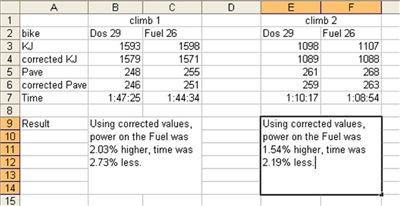Note (added 2/3/06): comments to this post have been disabled due to malicious spammers. You know who you are. Contact me through the "contact me" link if have something you'd like to add. If there is enough interest, I'd consider opening a public forum for the issue.
Note (added 2/12/06): this test looks at comparisons for climbing relatively smooth but variable pitched long dirt road climbs. For an analysis of rolling, twisty singletrack, check out http://teamhealthfx.com/blogs/dave_harris/archive/2006/02/10/510.aspx.
Thanks!
-------------------------------------------
Which one of these are faster? This is the question of the hour. Every 29er fan would have you believe 26" wheels are "kiddie" wheels and also that 29" wheels are faster. Time to cut through all the subjectivity and put some numbers on the problem. The short answer: for this comparison, the 26" wheels outperformed the 29" wheels, but it's not an overwhelming difference. Then again, the margins between winning and losing are often quite small...
I've got a Salsa Dos Niner and a Trek Fuel 110, both setup with power tap hubs. In the past week I did the same ride twice (4 Peaks road from hwy 87 to hwy 88 and back), a 60 mile dirt road/jeep trail route with approximately 11,000 feet total climbing. Two sections of the ride are compared: the first climb, which is partly rolling with some steep climbs and one long climb, rising about 4,000' in the process. The second section climbs from hwy 88 back to the high point; this climb is quite steep, climbing ~4,000 in 8 miles. There are a few short descents.
Bike setups: The Dos was setup with Specialized Fast Trak tires, tubeless ala Stans. The Fuel was setup with a tubeless (plus Stans latex) Panaracer fire XC pro rear and a WTB Weirwolf 2.3 front, tubeless ala Stans. The Dos is .6 lbs lighter than the Fuel, as measured by a Tanita scale (.2 lb increments). I started each ride with the exact same amount of water & food so as to eliminate rider weight changes. I assumed my weight to be the same on both days.
First off I just went out and rode the routes. I made no attempt to ride even paces for any sections of the ride, and in fact, the latter ride (on the Fuel) was done at a more spirited pace. I just planned on sorting out the data post-ride.
Next, I had to come up with correction factors for the power meters. Power taps are strain guage devices, and as such, have a small but significant precision variability. I performed a stomp test for each power meter (including my road bike PT), here's how they turned out:

Based on the stomp test, the 29" PT measures .86% high, while the 26" PT measures 1.75% high. This leads to correction factors of .9915 for the 29" and .9828 for the 26".
Now there's nothing left but to look at the data for each climb:

The road surface is sandy in spots, rocky in others, and fairly loose decomposed granite throughout.
Conclusion: in this test, the 26" wheels outperform the big wheels. The first "climb" has a lot of rolling terrain, I was interested to see how this would turn out. In the end, though, a consistent advantage exists for the 26" wheel, whether rolling or straight up climbing. On the steep climb ("climb 2"), one would expect a linear decrease in time for a linear power increase. IOW, a 10% power increase should decrease time by 10%. This is because the major resistance to overcome is that of gravity - a constant. Yet the Fuel saw greater speed increases than linear with power increases. I could feel this on the ride - any change in speed necessitates wheel accelerations, and the big wheels are simply slower to accelerate. The smaller bike feels much more "lively" or "responsive".
Another interesting detail is how closely the kJ tracked for each climb. Identical for the big climb! This is somewhat surprising given that the Trek was .6 lbs heavier.
Clearly, a test on a dirt road is only valid for similar conditions...so I'll do more tests off-road. But I'm becoming biased now. The acceleration issue of the big wheels is tough to overcome...I suspect they will be best suited for rocky/tech stuff.
One more data point: at Moab, I did a lap each on the Fuel, Dos, and the 292. I never did a lap on the 292 that was within a minute of the Fuel's lap time...
More to come!